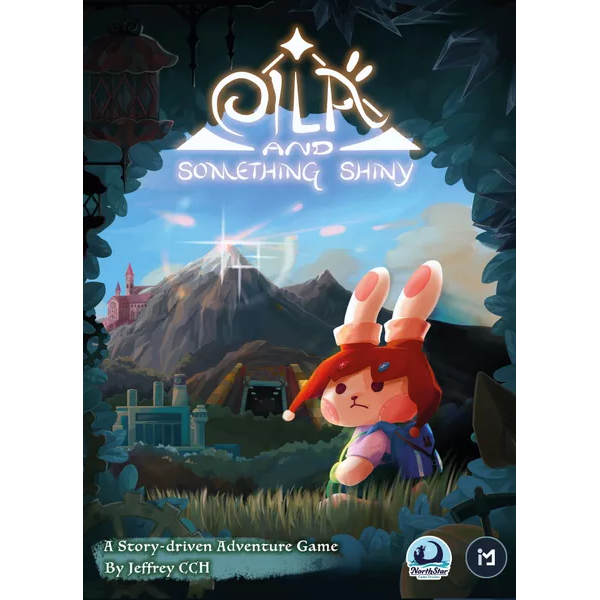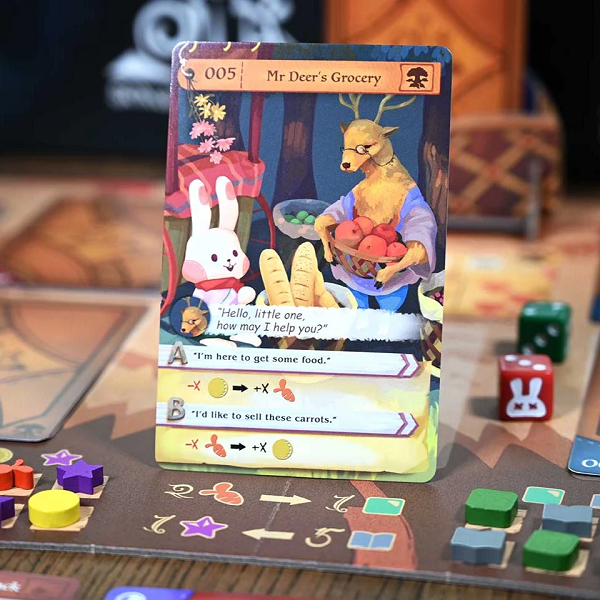Embark on a Dark and Gripping Solo Adventure with Eila and Something Shiny

A little bunny, Eila, lives in the woods. However, she is about to embark on an epic journey to reach the mountain's peak and discover what the shiny thing is.
Originally released through Kickstarter as an indie game, Eila and Something Shiny is now being released by NorthStar Game Studio. It is a solo (or cooperative) story adventure game for ages 12 and up that is played over five chapters, with each chapter taking roughly 30 minutes to play.
Gameplay
The game is played over the course of five chapters. Each chapter comes with three decks of cards: yellow, blue, and red events. Each one is numbered. You separate the decks and put the yellow event cards, in numerical order, into the card holder. You then read the little comic book prologue for the chapter you are playing.
Each chapter takes place over seven rounds, with each round representing a day and a night. During the day, you draw each card from the card holder and resolve it. When resolving an event card, you will read the title and any text on it, and then make one of the choices on the card. Some choices will require you to spend resources in order to make them, or require you to have specific items. The card will also list what will happen if you make that choice. You might gain resources, you might draw a card, or even lose health.
If a choice has you draw a blue event card, you add it to the future discard pile, face-down without looking at it. If a choice has you draw a red event card, you place it in the front of the card holder so that it will be the next card you draw.
After you make the choice, the choice you made will tell you if you discard the current event card to the past discard pile where it will not be used for the rest of the chapter, or if you place it in the future discard pile.
There are six types of resources. There are three tangible resources: coins, carrots, and magic stones. There are also three intangible resources: fear, knowledge, and energy. You can carry eight tangible resources, and eight intangible resources at any time. If you gain resources and would go over your limit, you may choose to swap them out for resources you are already carrying, except for fear, which can only be gotten rid of through choices. At any time, you can spend two carrots to get one energy, or five knowledge to gain one magic stone.
Once you have drawn all the cards from the card holder, you move on to the night phase. During the night, you must spend one energy or one health. Each chapter gives you a different amount of health, and if you run out of health you lose the chapter. Typically, each chapter also requires different amounts of resources to complete them and you have to wait until night to spend them towards this goal. Some chapters do have alternative ways you beat them, and some chapters have multiple possible paths to completion. Finally, you end the night by shuffling all the cards in the future discard pile and adding them to the card holder. You then move on to the next round.
If you complete the chapter before the end of the seventh night, you win and read the little comic book for that chapter’s ending. You can now go on to the next chapter. If you fail to complete the chapter, you return any item, habit, and support cards you gained in that chapter, reset the event decks, and try the chapter again. Habit cards are like event cards and are added to the card holder when you gain them and are always placed in the future discard pile after you finish resolving them. These typically help you gain resources or deal with fear. Support cards and item cards also provide bonuses or open up extra choices in some events. Habit, support, and item cards are the only things that carry over with you between chapters.
Different chapters will also have their own unique rules and components that get added to the game for that chapter only.

Photo provided by the publisher.
Review
Eila and Something Shiny blends mechanics with the choose-your-own-adventure style of gameplay quite nicely. It runs too long to really be considered strictly a casual game, but for this type of story adventure game, it is easy to learn, and you can play it in bite-sized chunks. The box says that each chapter takes 30 minutes, and I found that to be fairly accurate. The game does increase in difficulty as you go, so you’re likely to have to replay a few chapters. At the very least, this will probably take you four hours to complete, and possibly more. It’s a pretty easy game to save and set up again later, and it is still possible to play through it all in an evening.
The mechanics are really enjoyable. You’re trying to manage your resources, both to meet the needs of the chapter’s goal as well as the needs of the individual event cards. As your bunny develops different habits or acquires different items, different resources also become more valuable to you or easier to convert into other resources, so as the game progresses you do get a satisfying sense that you’re approaching each chapter with your playstyle and combination of strengths. You can see situations in which your strengths are particularly useful, or moments when another skill or tool you passed on would have come in handy. This helps to make your choices feel relevant.
Having special rules and components for each chapter helps to keep the game feeling fresh as you play through it, and none of the special rules are too complicated or onerous to learn, and they make chapters feel unique.
Events are so well handled in this game and are just enjoyable to read. They often have flavor text and the artwork on them is just beautiful. The way they add cards to the future deck gives weight to your choices as you see how new events unfold, and it’s always exciting to see what will happen next.
The fact that the future deck is always shuffled means there’s some luck of the draw to keep the game from becoming simply a numbers game for your resources. You might know an event is coming up that will require carrots, and you might know you have an event in the deck that will give you those carrots. But you can never be sure in what order those events will pop up. So, sometimes there is a push-your-luck element when choosing to spend resources on an event and when not to.
As the game increases in difficulty, so do the odds that you might have to play a chapter through more than once. However, while you’ll know now the events that will happen (although you can sometimes make different choices that will lead to different events going into the deck), you can use this knowledge to work towards the resources you know you’ll need later in the chapter, and that shuffled future deck continues to add some unpredictability that keeps the game suspenseful even when you know generally what is coming.
The game is gorgeous, and the components are all excellent. There was one production issue, however: the decks in my copy were packed backward, so each time I opened a new one, I had to put the events back into numerical order. Even the ‘this is the bottom of the deck, don’t look through the deck and spoil the game for yourself’ card was in fact on top of each deck rather than on the bottom. Being familiar with this type of game, I figured out the issue during my initial setup, and it was very easy to fix as the back of each card has its number very clearly displayed — but it would be easy to get confused by this.
Eila and Something Shiny does have some dark themes. The bunny and the artwork is very adorable and cute, but NorthStar Game Studio has recommended it for ages 12 and up, and this feels pretty fair. There’s nothing so dark here that you couldn’t find it in some children’s films, and it would probably be fine for children a little younger than 12, but parents would definitely want to look at it for themselves first, and younger children might just not enjoy the story by the end.
The story is very gripping and I was very invested in my bunny and her tale all the way through. The final chapter, however, left me with some mixed feelings. Chapter five is quite difficult and took me several tries to complete. I did enjoy this, trying to figure out the best path, how to get the resources I needed, and preparing for the finale. But there are three endings to the game, and the one you are most likely to get is a bit…unsatisfying. I think the game is trying to encourage you to play through the whole thing again, to try and get the other two endings, and the gameplay itself is worth replaying, as is the fact that you can create different builds for your bunny and therefore approach problems differently. But when you end on an unsatisfying note, it doesn’t really leave you feeling compelled to play again.
It also felt like the game could have been a bit more forgiving on the barrier to get the ‘true’ ending, or at least add an additional ending for players who were close to qualifying for it. Given how your ending is determined, based on certain choices you made throughout the game, I didn’t feel like my ending fairly reflected all of my choices as a whole.
The game’s ‘true’ ending is ambitious and unexpected. Some players are probably not going to like it. It might not be the ending I would have chosen, either, but I admire the writer for going with something he clearly felt deeply about and that does have emotional weight. It definitely stuck with me, and left me thinking about it for some time after I’d packed up the game.
Eila and Something Shiny was a very enjoyable gameplay experience. It’s important to know going in that what you’re going to get is probably going to be a little darker than what you expect from the box. If you enjoy solo games, this one is a great experience and has minimal set-up, and easy-to-reset chapters when you lose. You can also easily reset the game and pass it on to someone else once you’ve finished.
Pros: Wonderful artwork and components, great blend of resource management and choice-based gameplay, easier to learn than other games in this genre, easy to become invested in the story
Cons: One ending is unsatisfying, themes might be darker than you’d expect from looking at the game, our copy had the cards in backward order
Disclosure: We received a complimentary review copy of this game.






